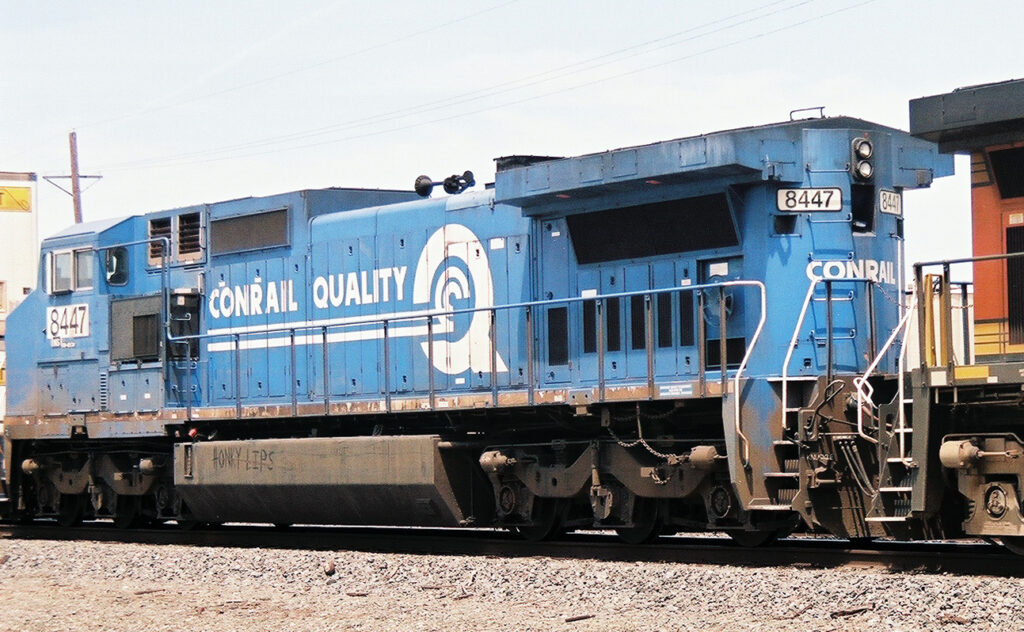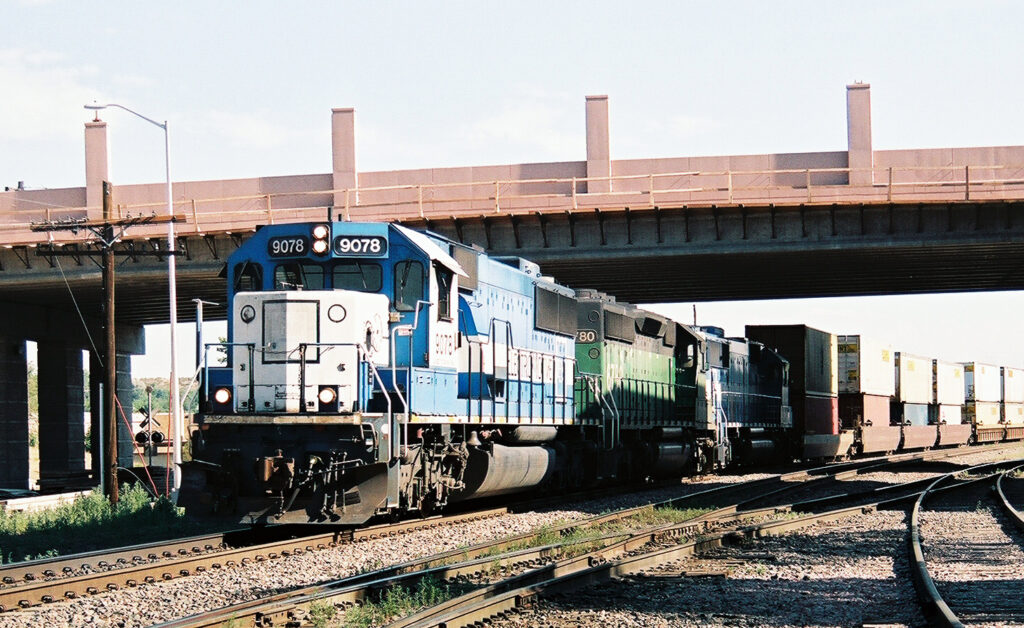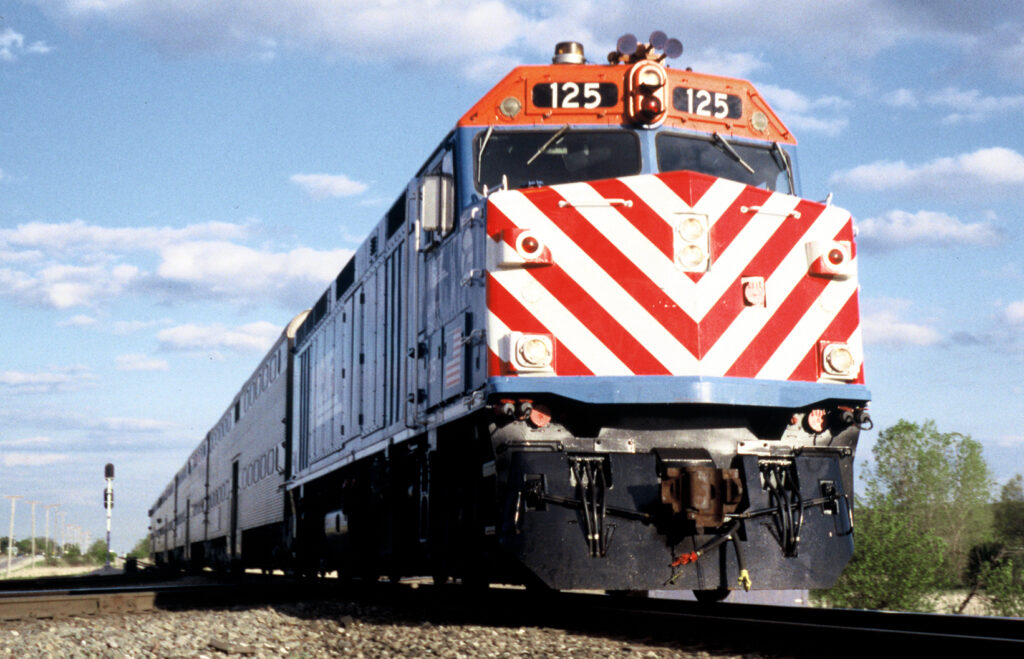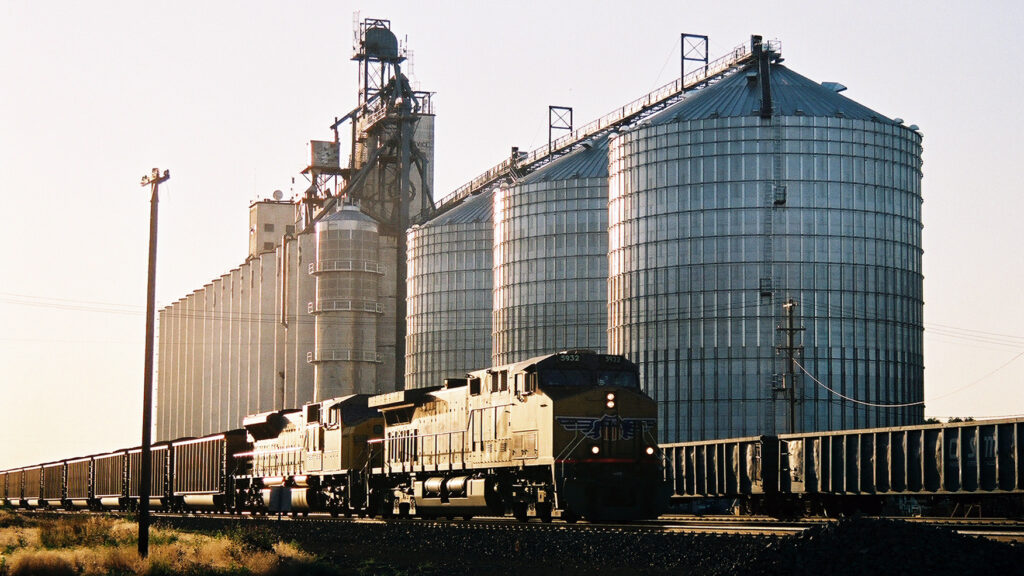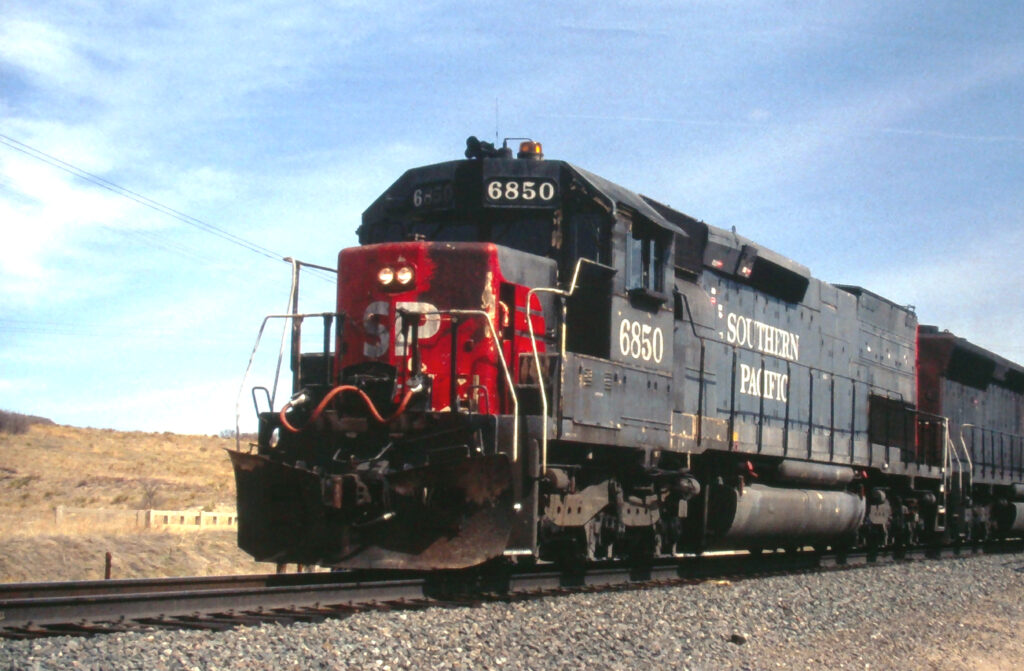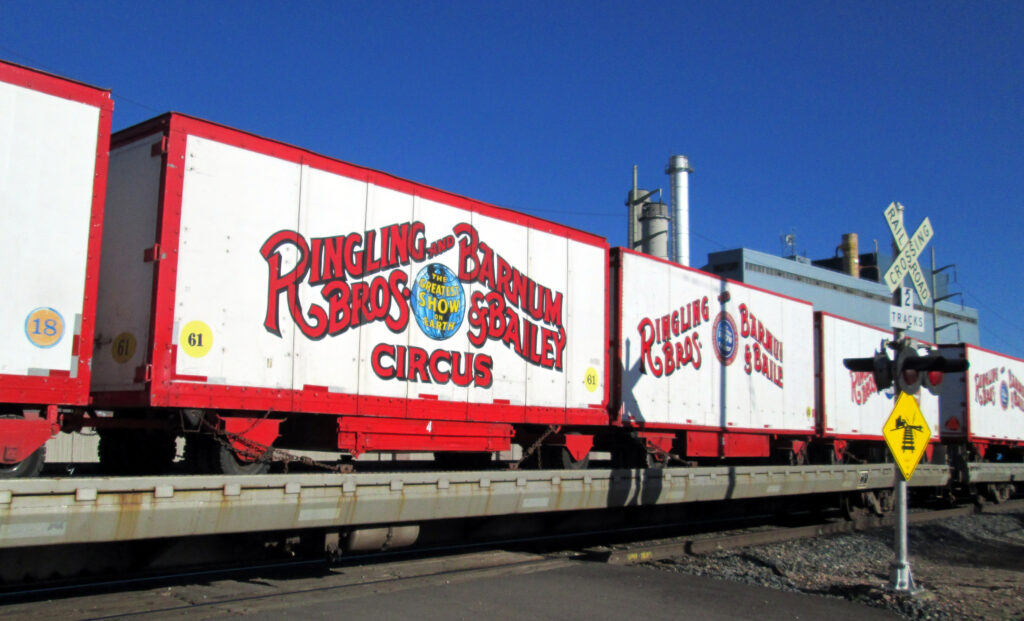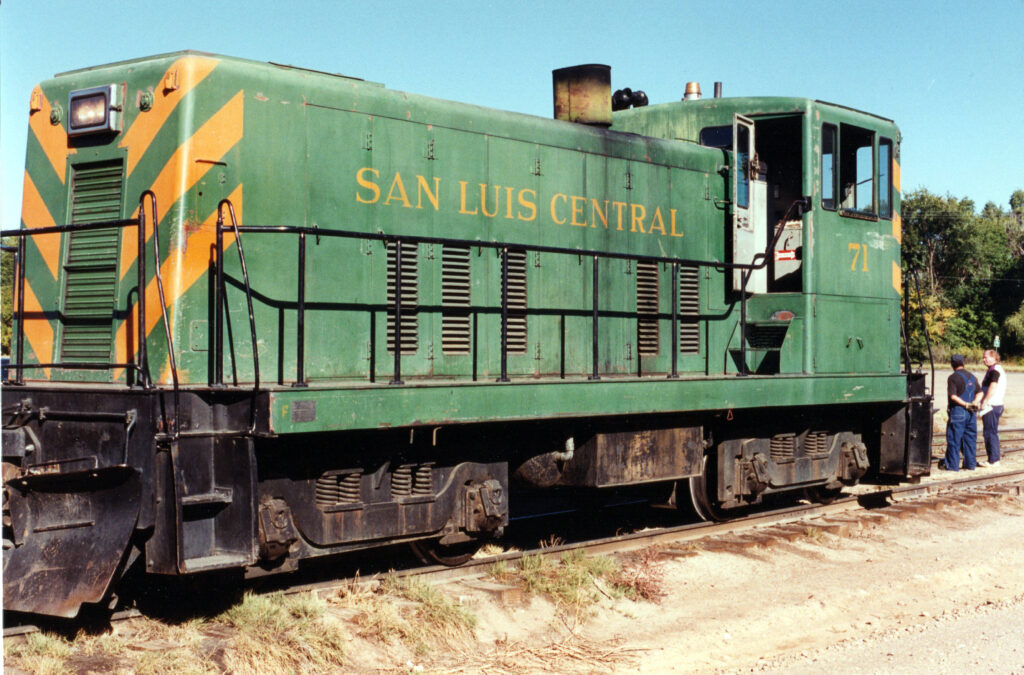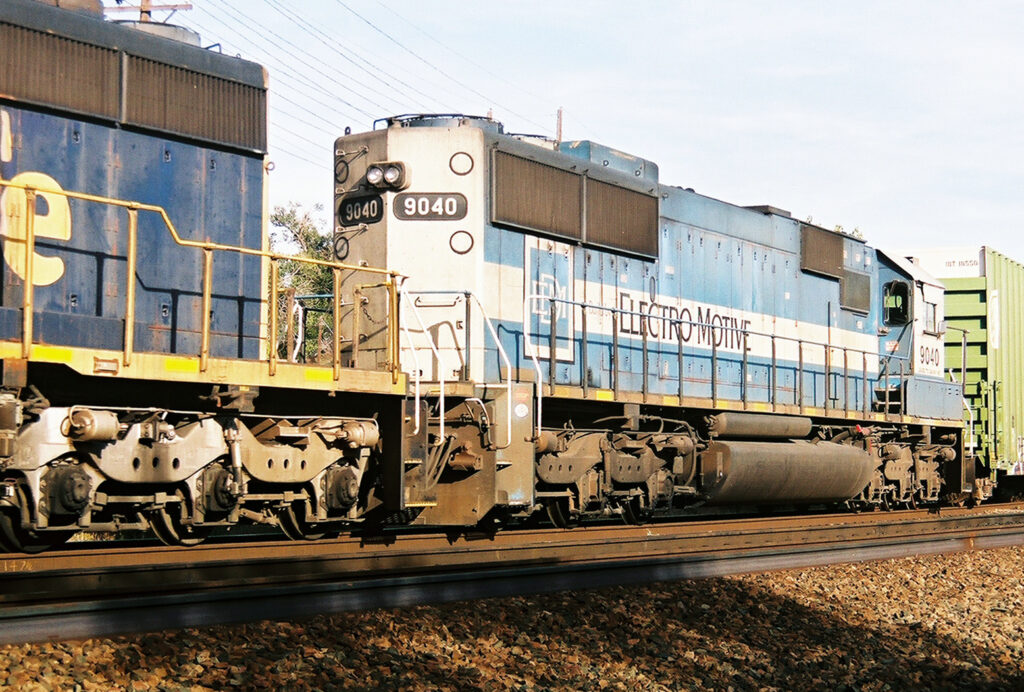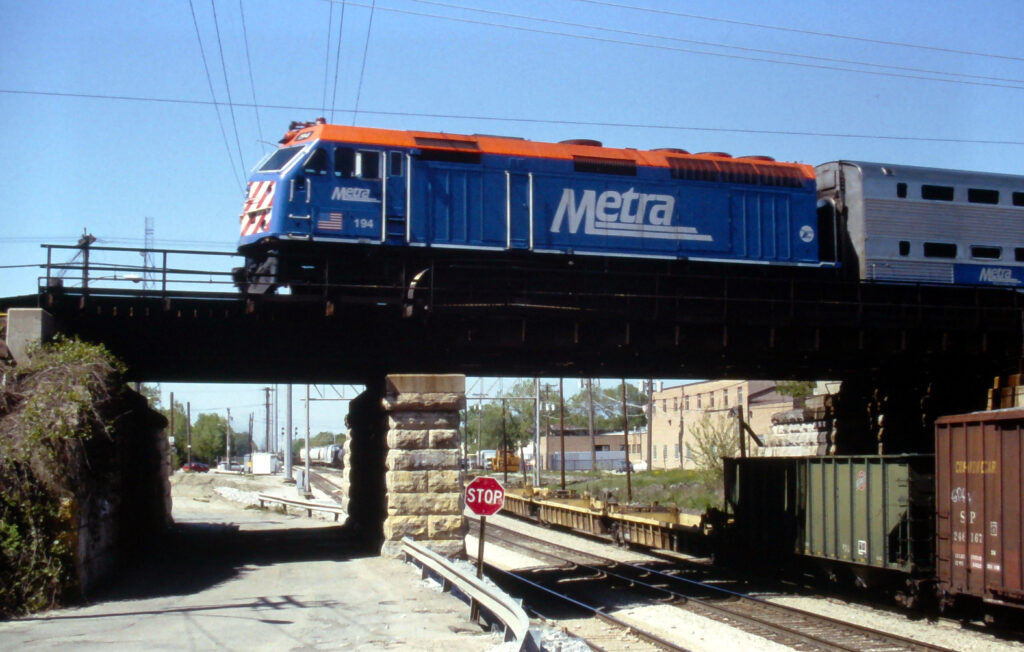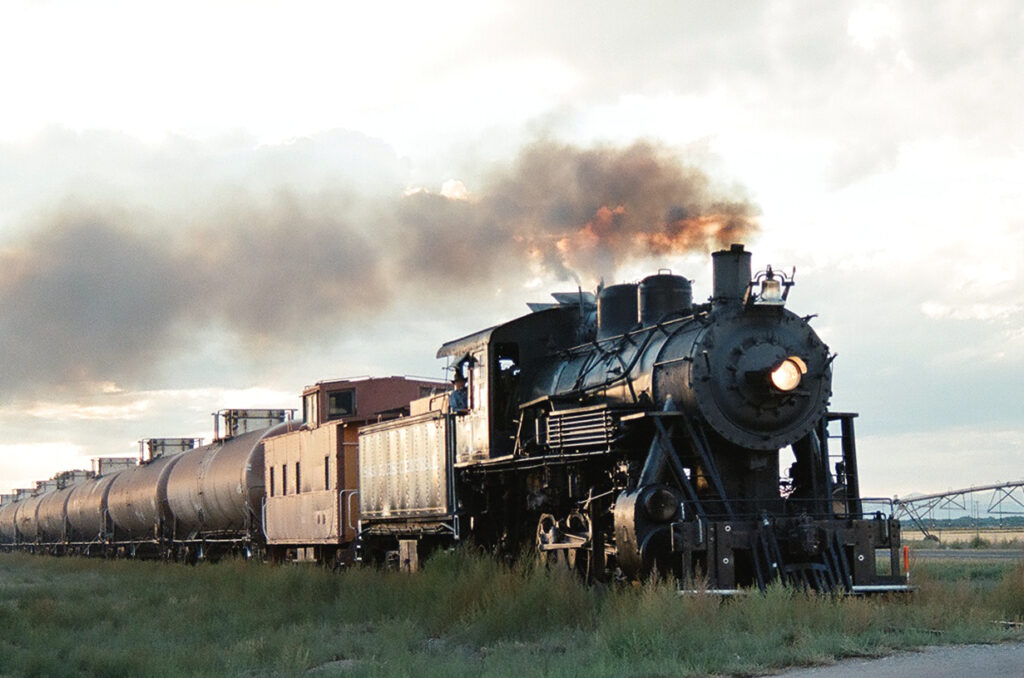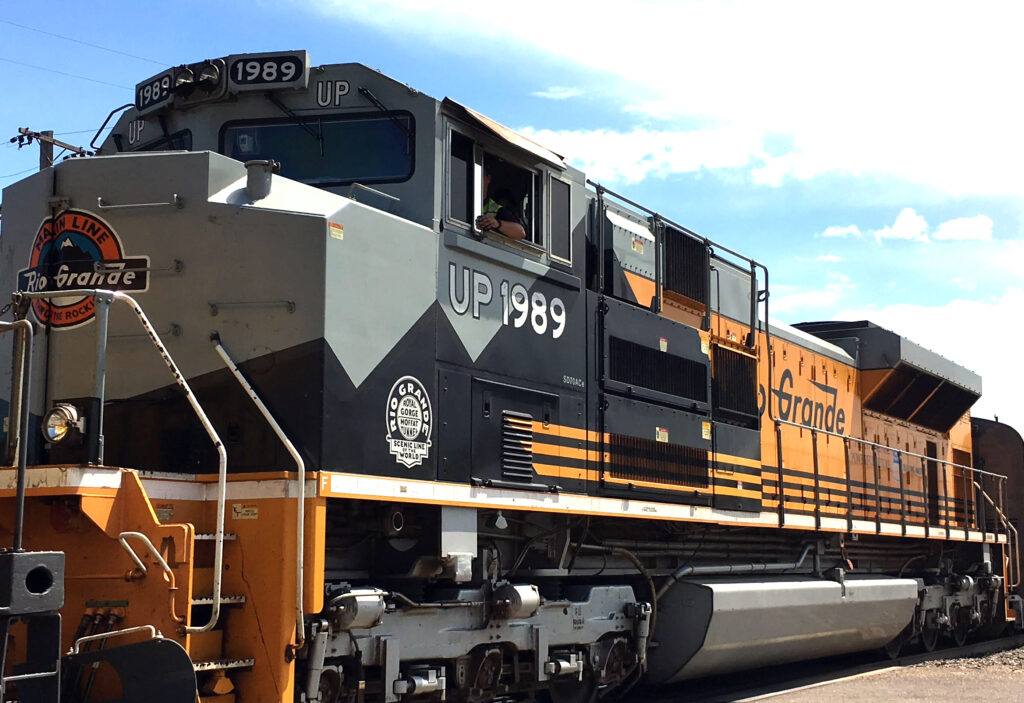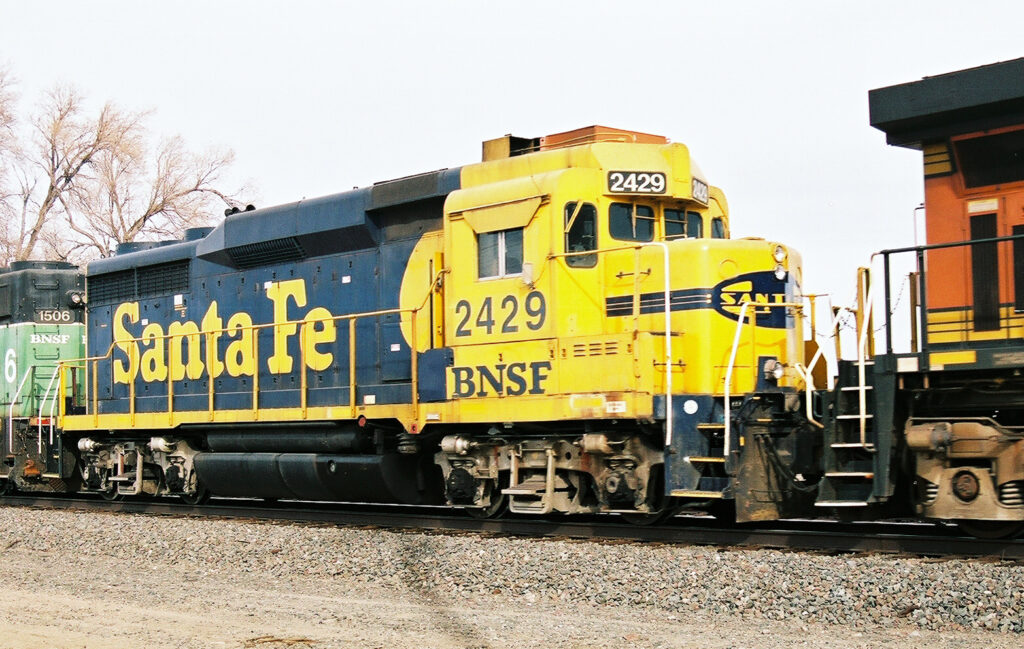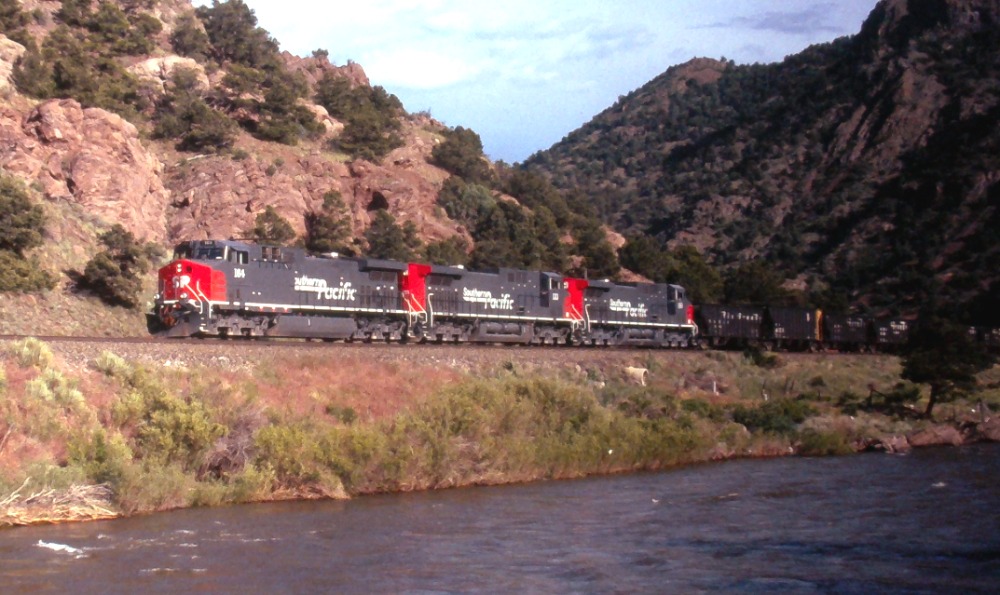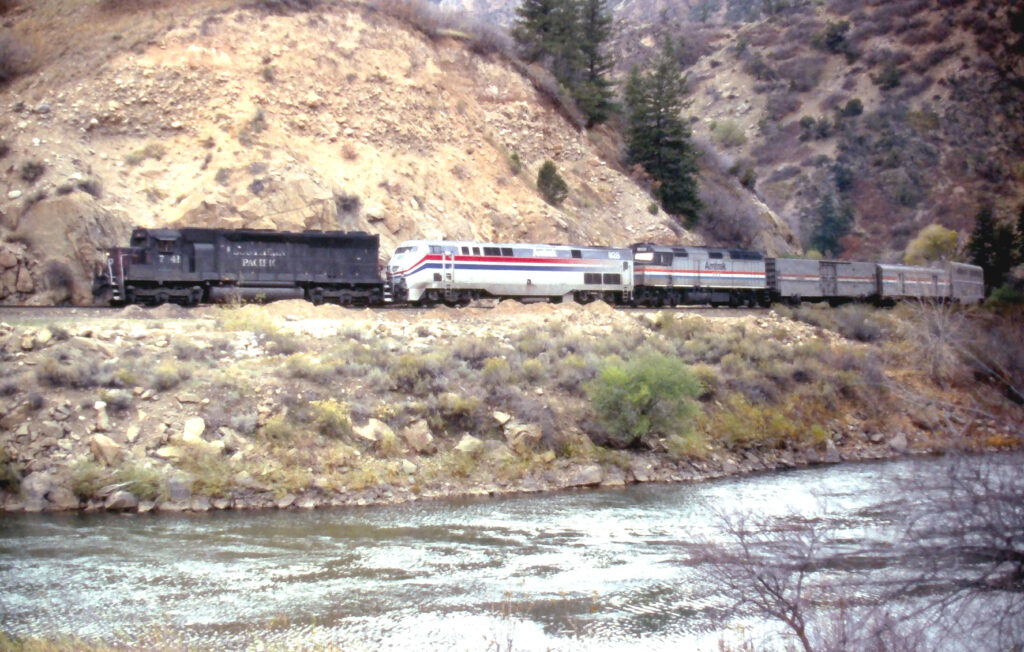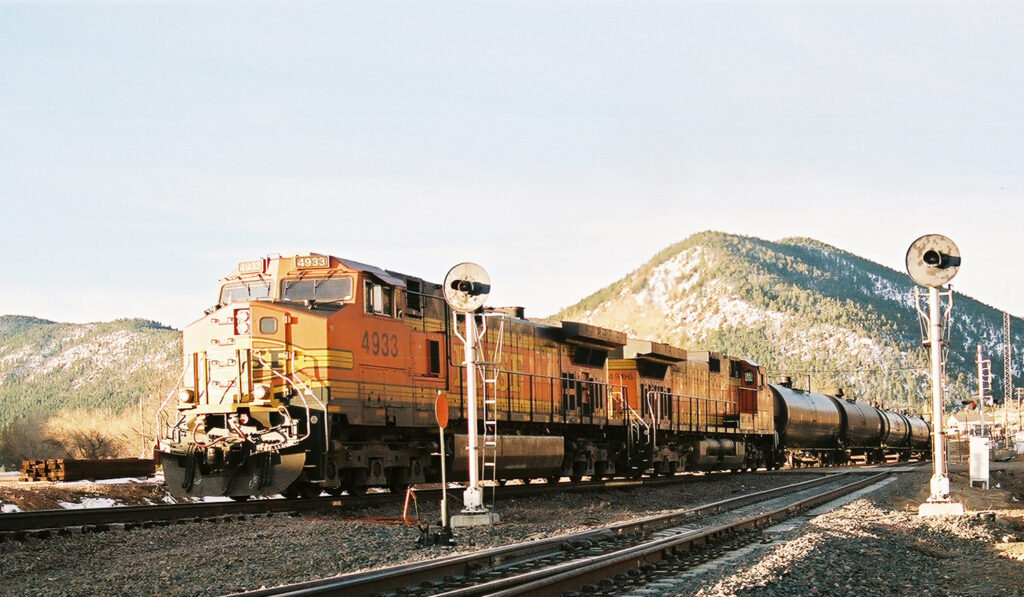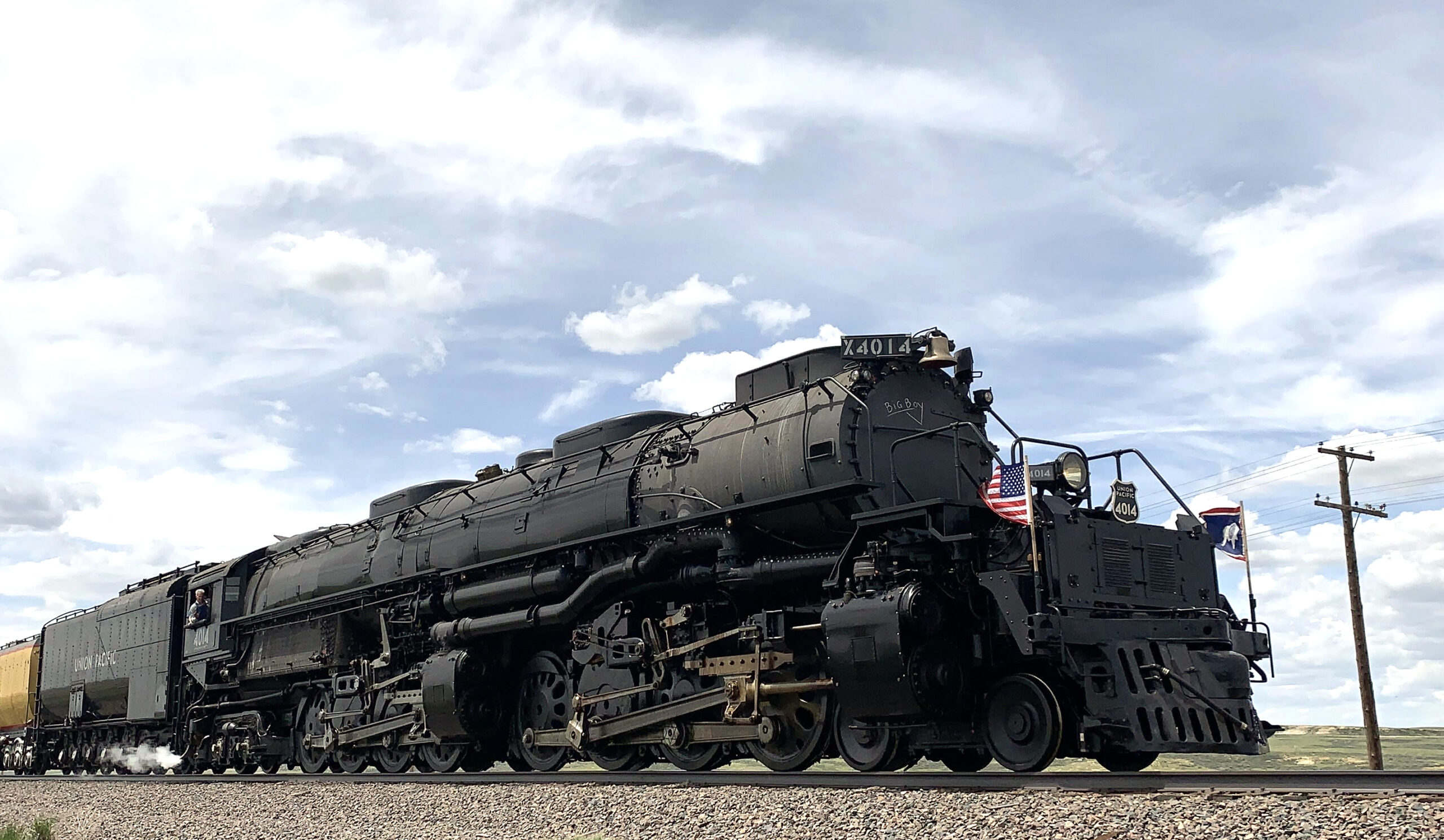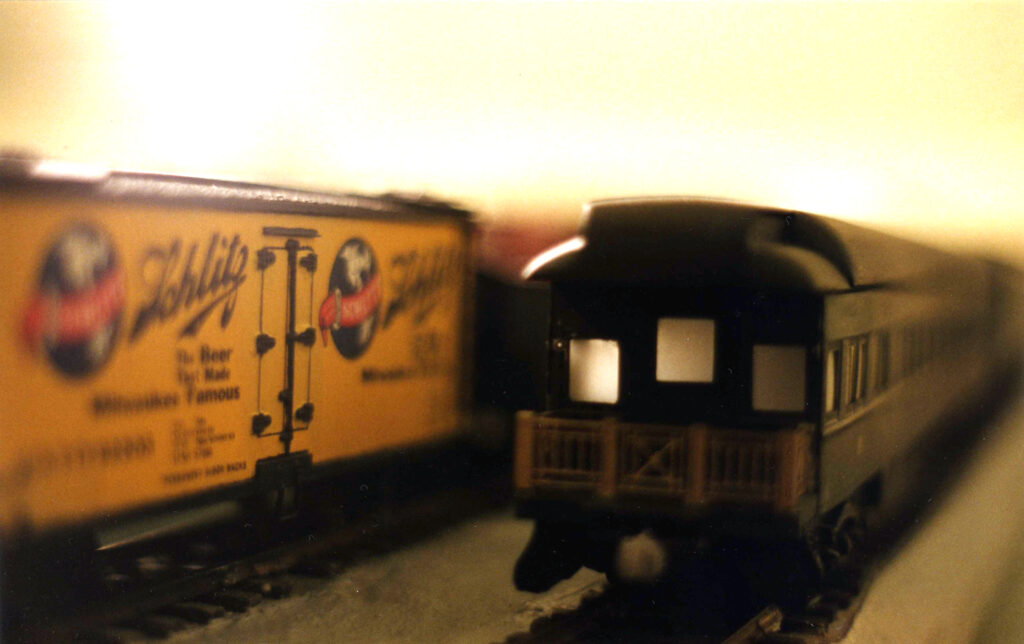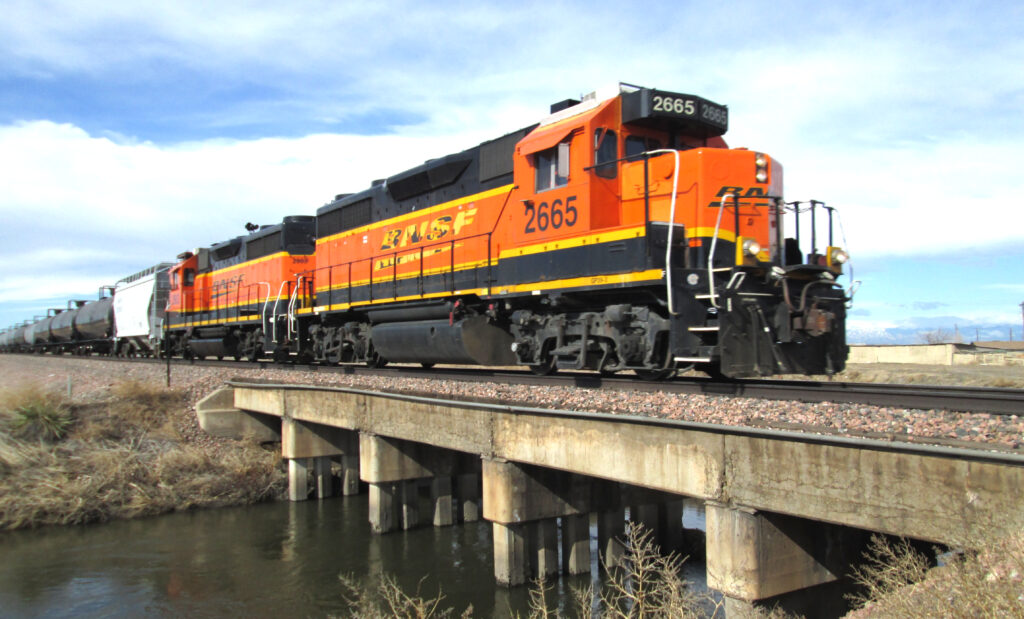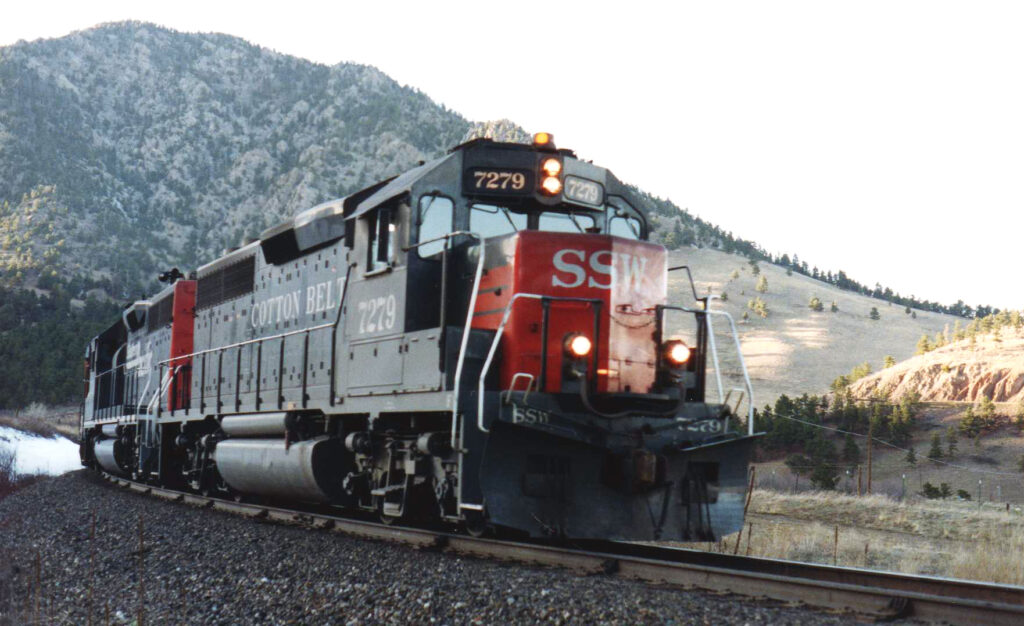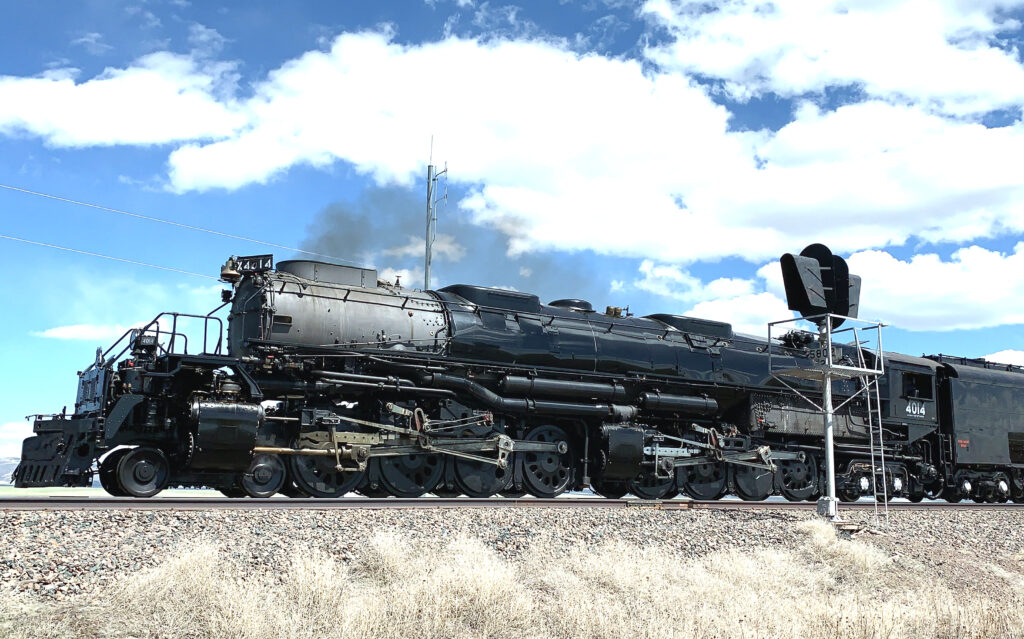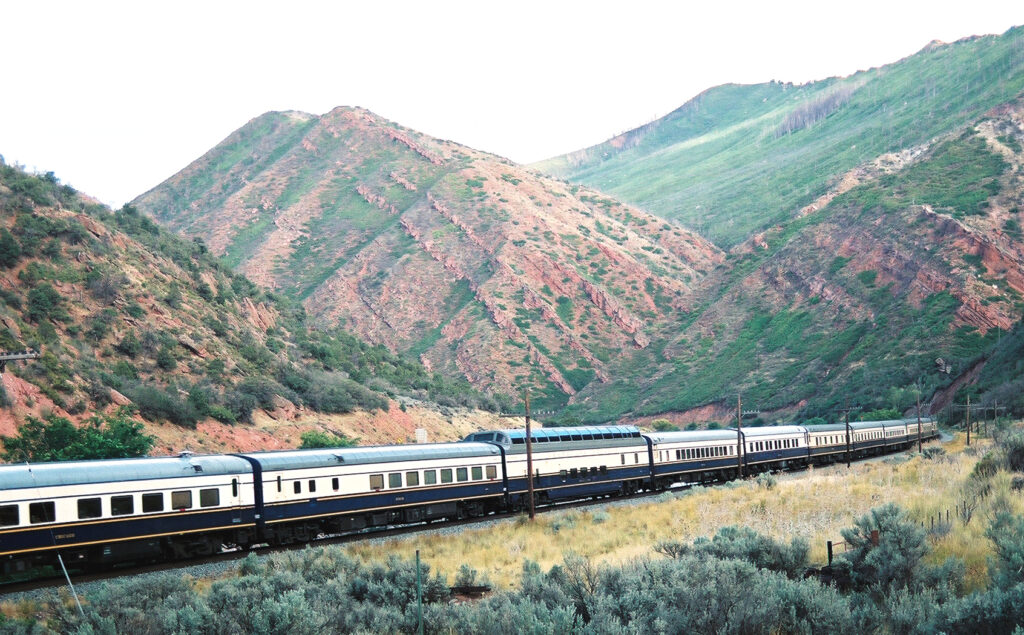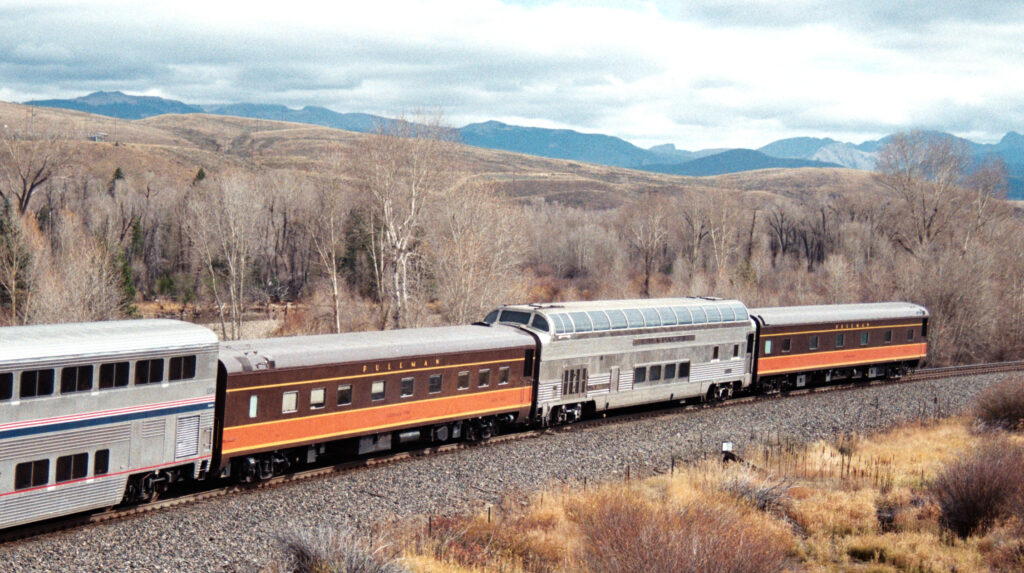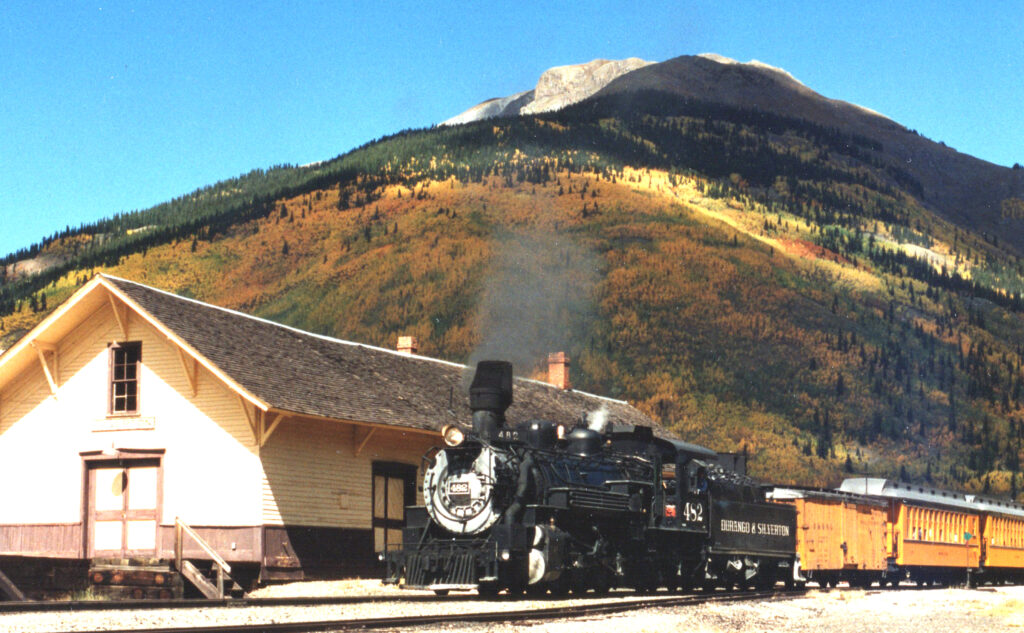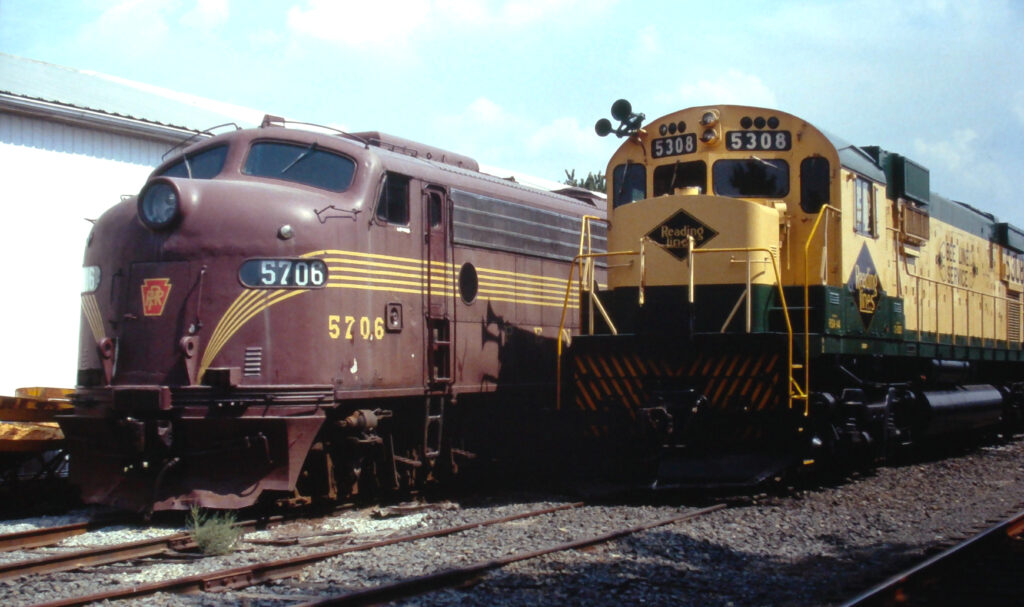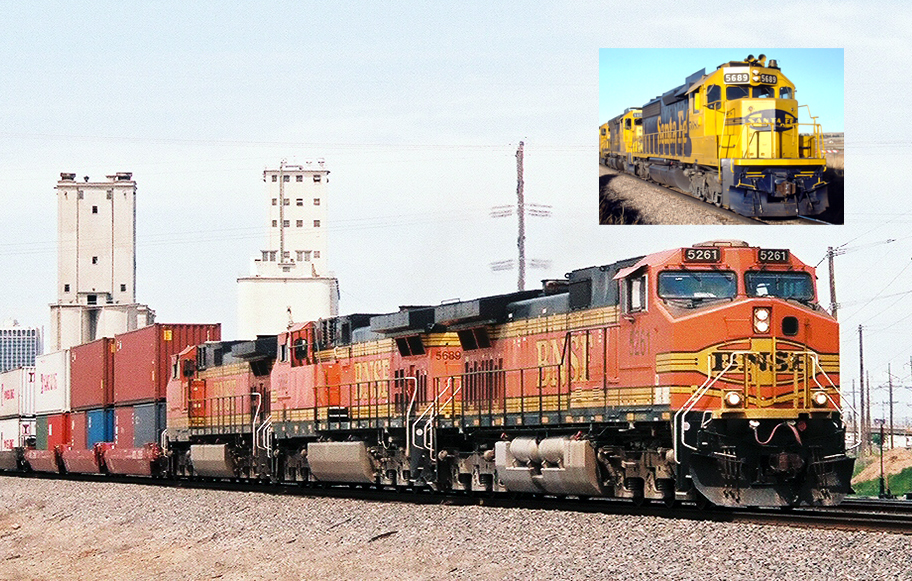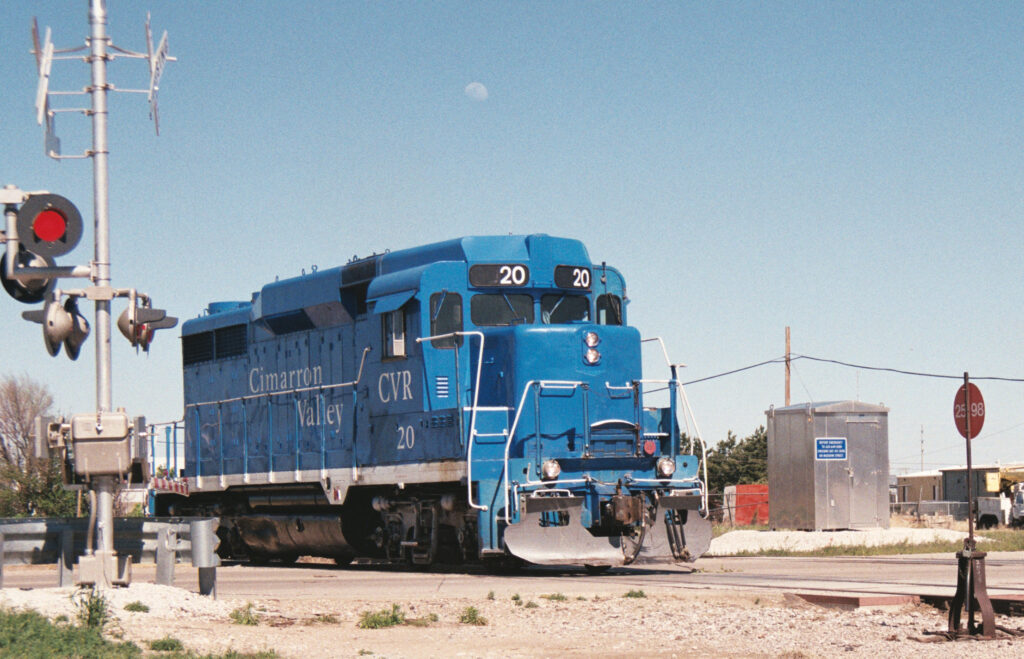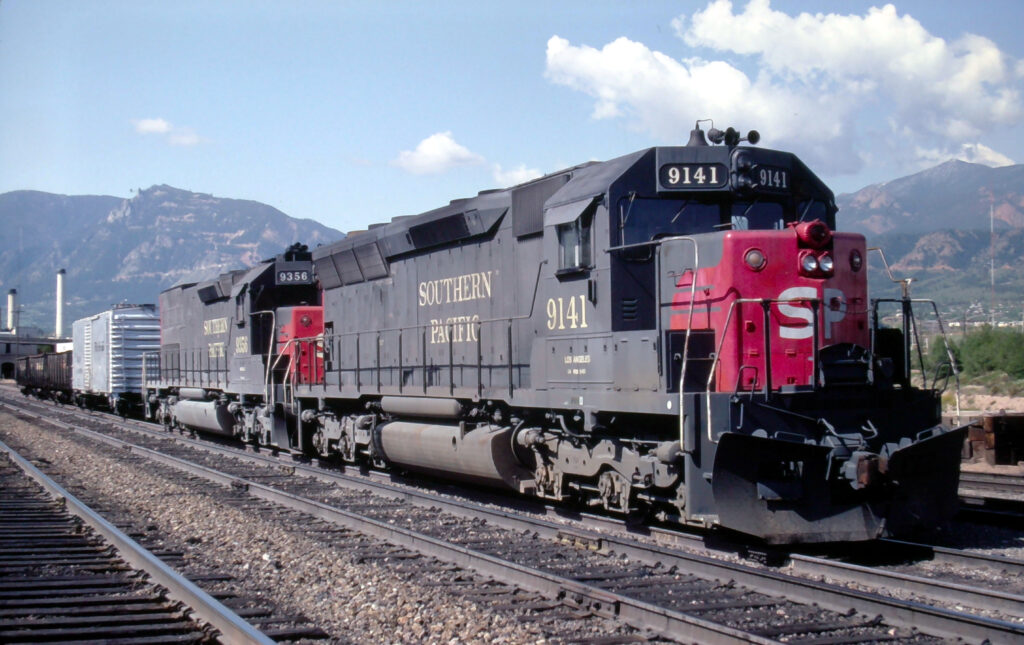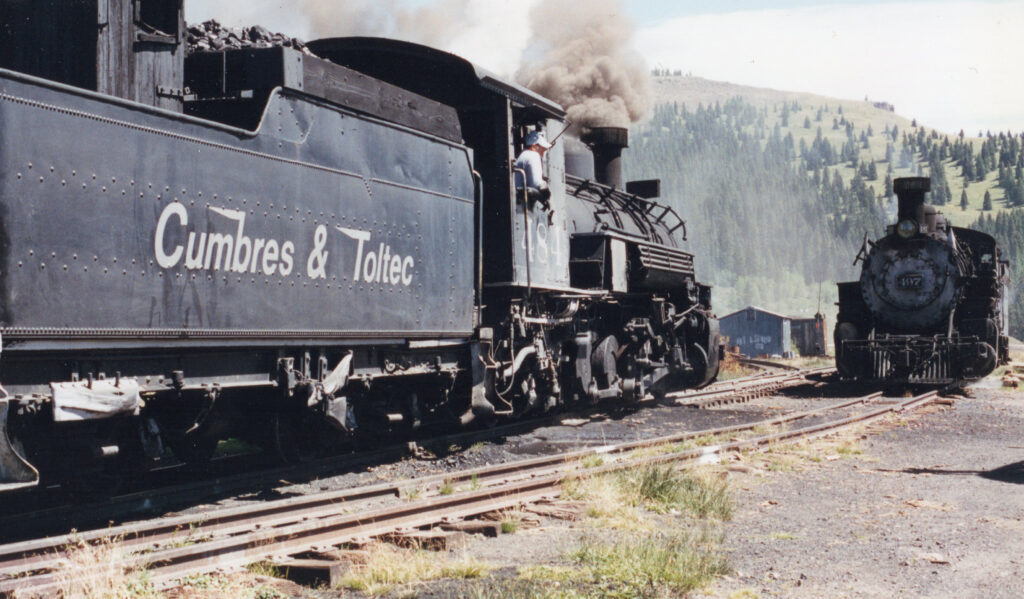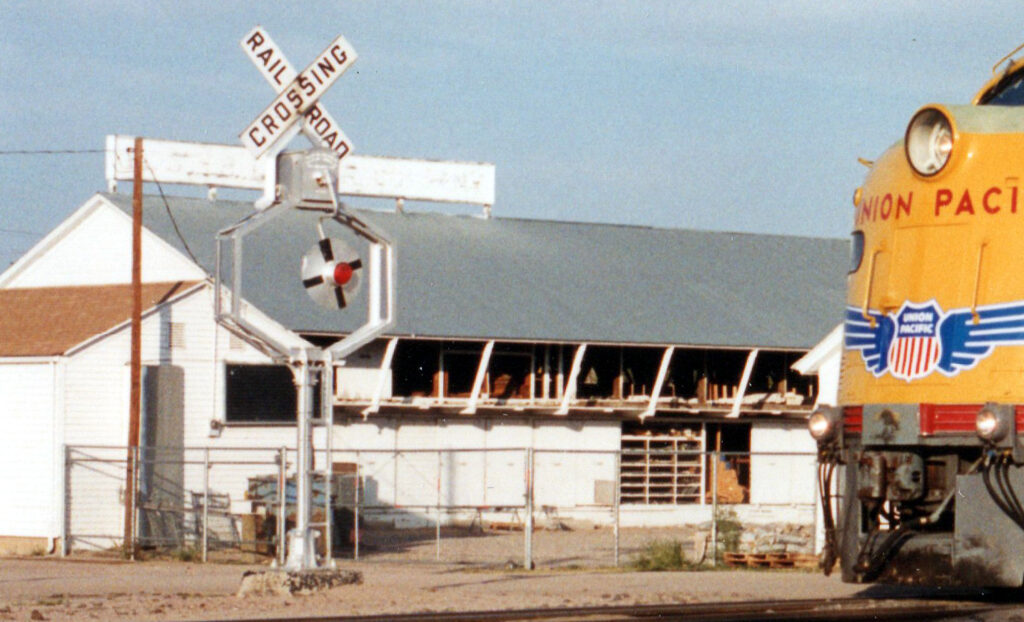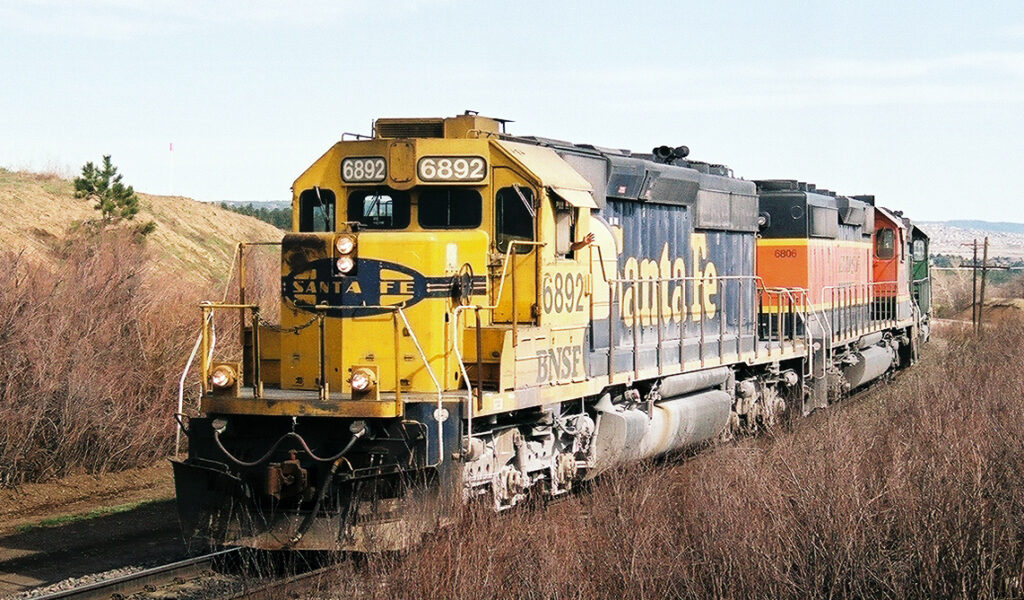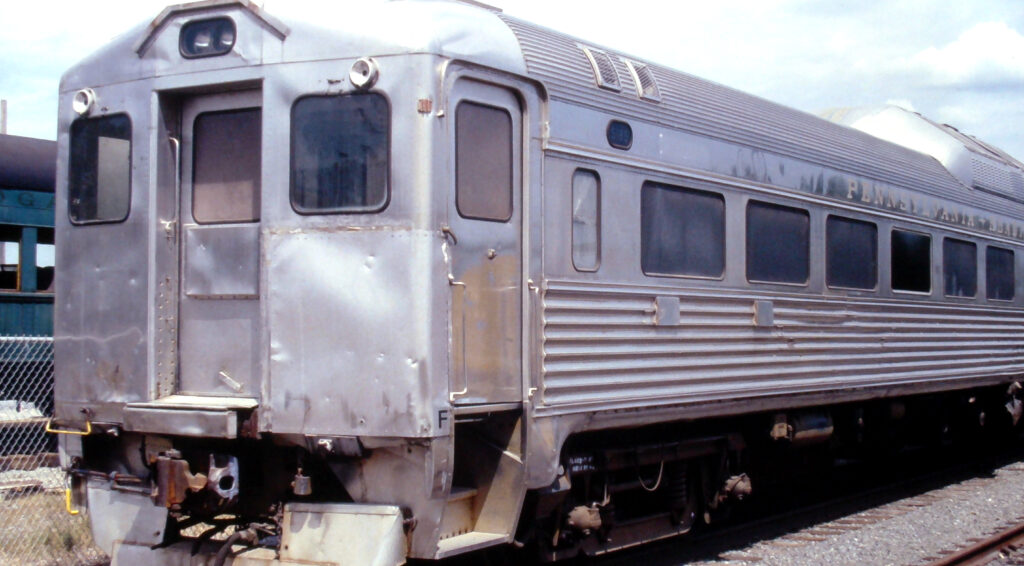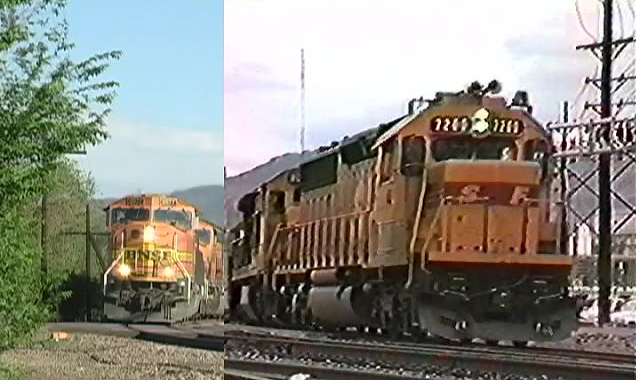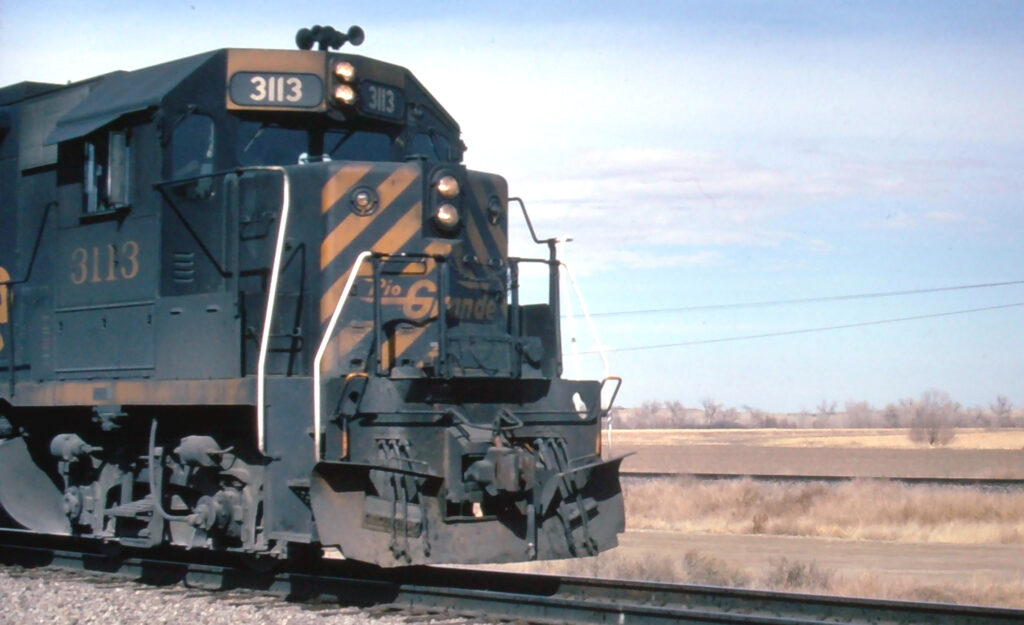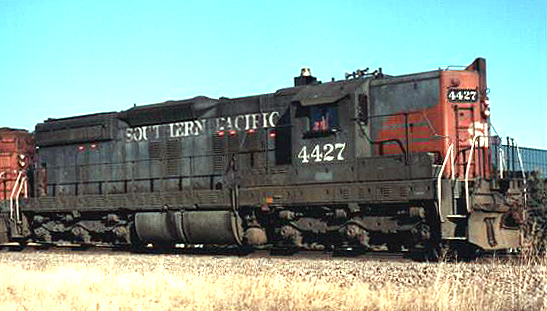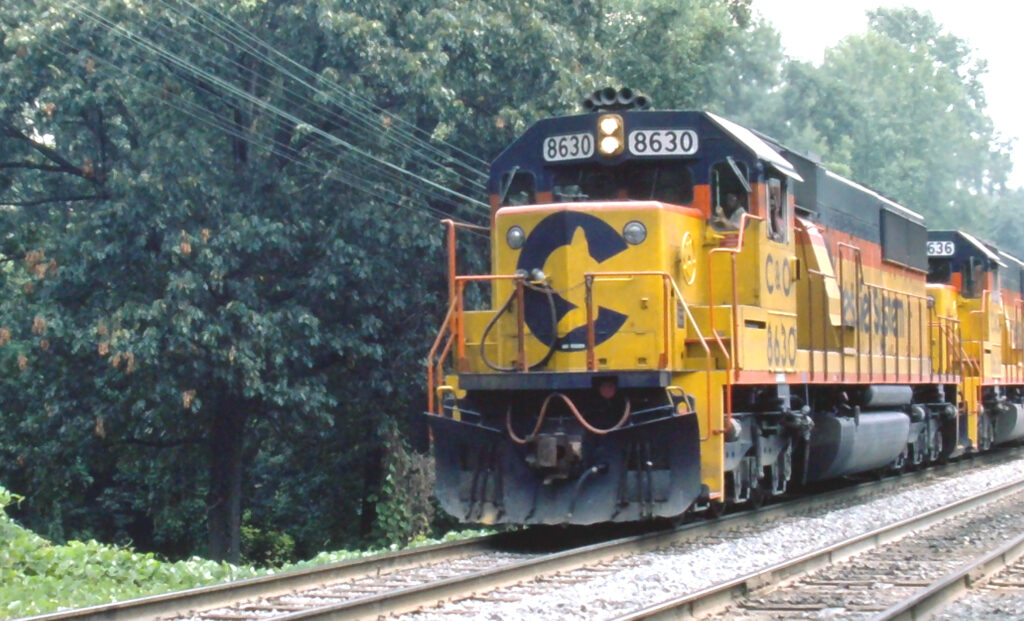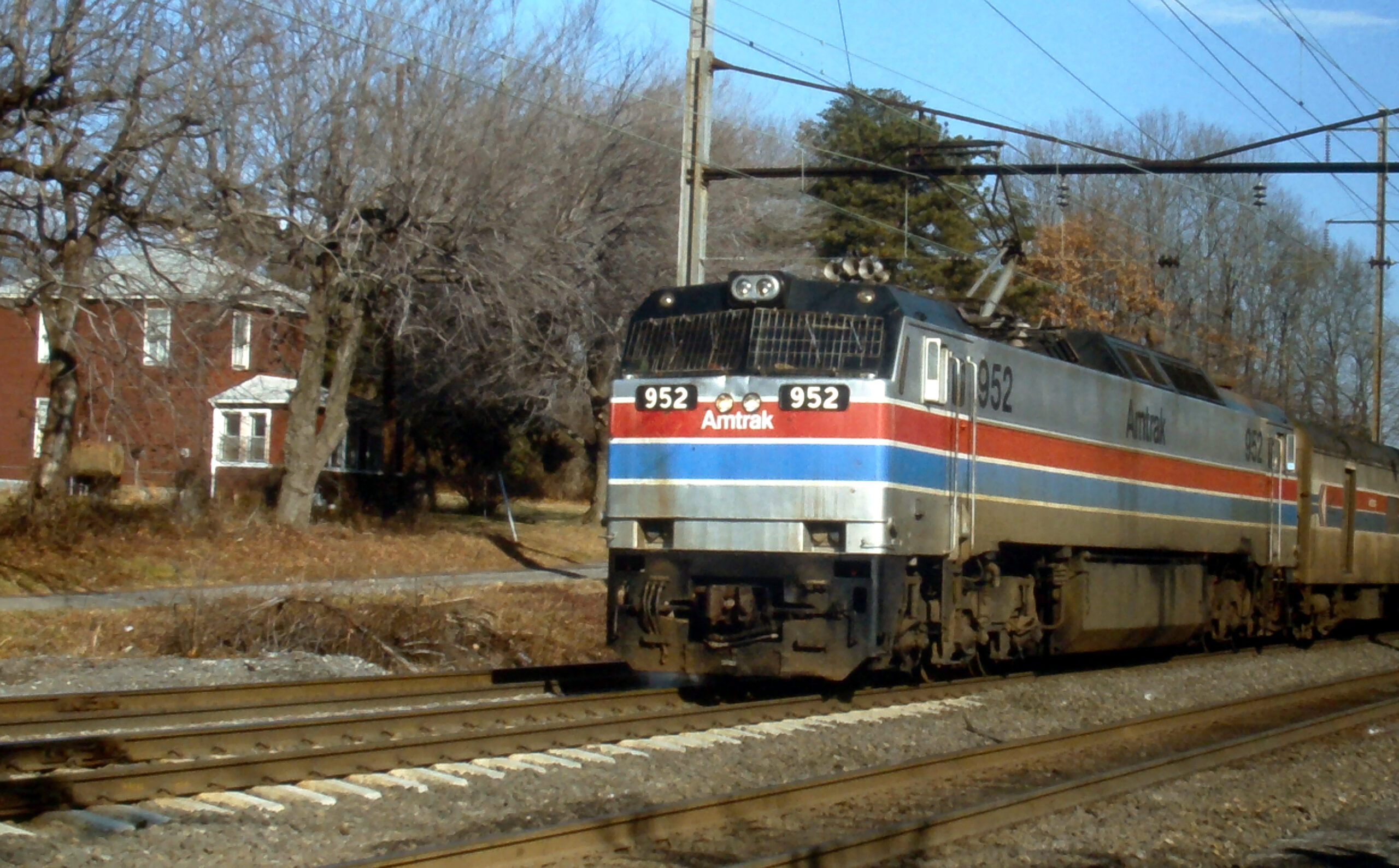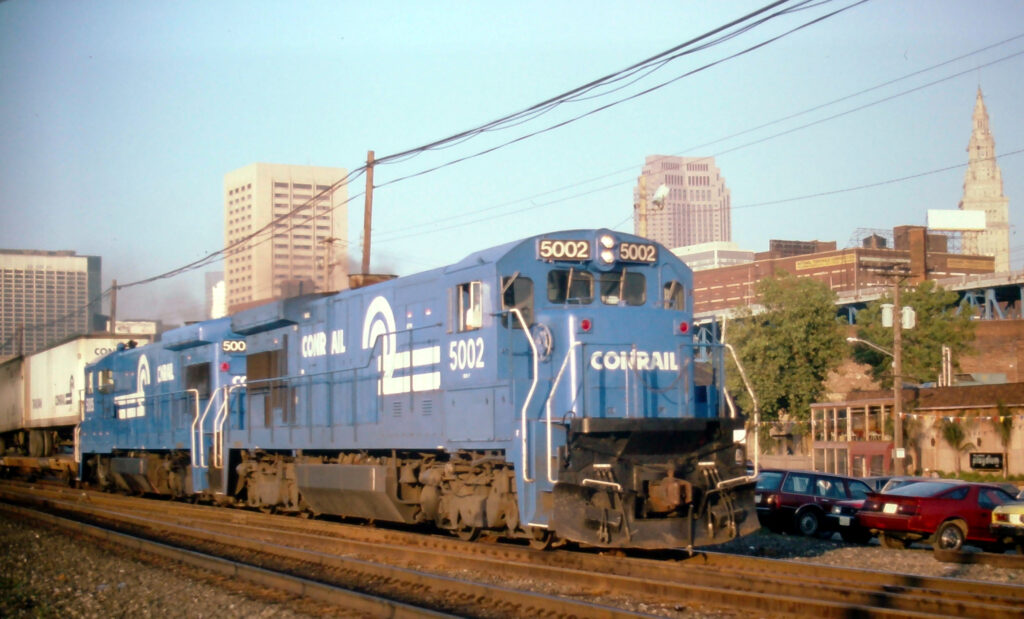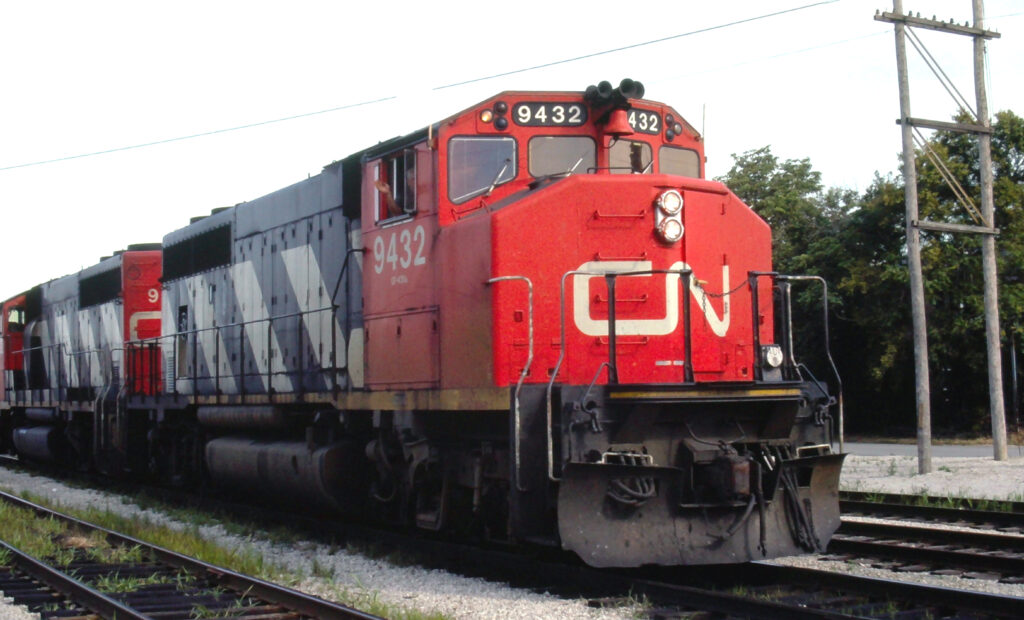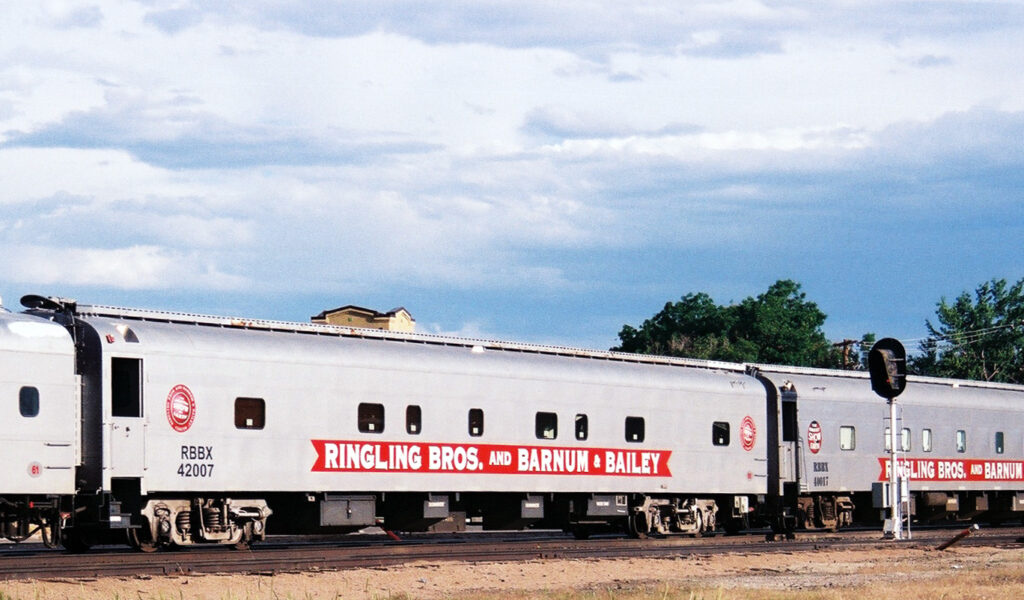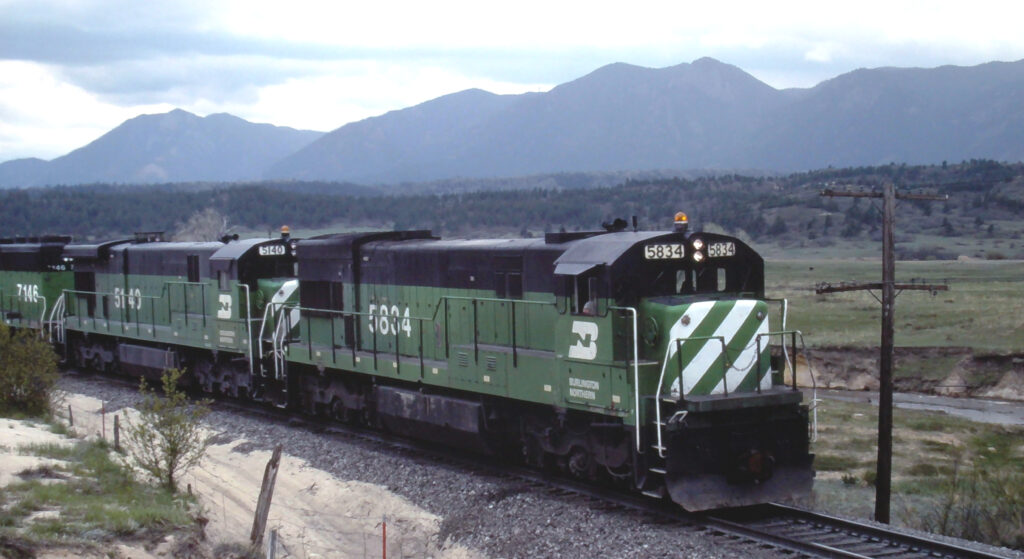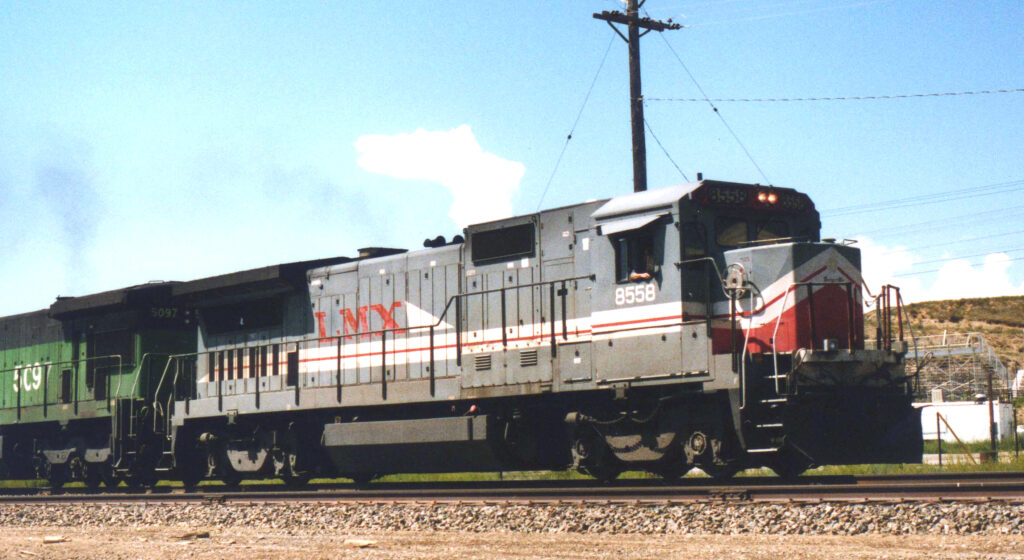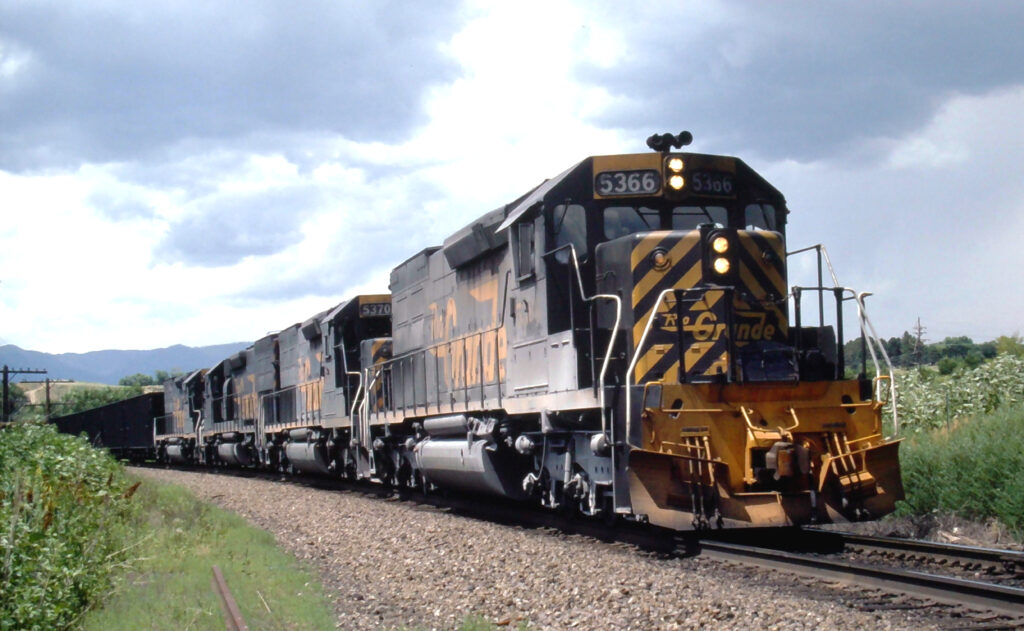Welcome to the Photos Page. Here you can click on photos and see their full media files, read descriptions of train photos, and look back on old photos that have previously been uploaded on my YouTube channel and Instagram!
Norfolk Southern C40-8W no. 8447 was the trailing unit on an eastbound Burlington Northern Santa Fe double stack train, leaving Amarillo, Texas, in 2007. Still in Conrail paint, no. 8447 was built for Conrail by General Electric in November 1994, originally numbered 752. It was renumbered CR 6278, then NS 8447 by February 2001. It was sold to leasing company Progress Rail Services in February 2020.
Colorado Front Range railroad Burlington Northern Santa Fe was pinched for motive power to haul coal trains and mixed freights in 2008. As a result, a plethora of leased locomotives and motive power from other railroads pounded over the mountainous Palmer Divide on Colorado’s Denver-Pueblo Joint Line. On August 2, 2008, leased SD60 no. 9078, from Electro-Motive Diesel (EMD), pulled a double stack container train southbound under the Cimarron Street bridge in Colorado Springs.
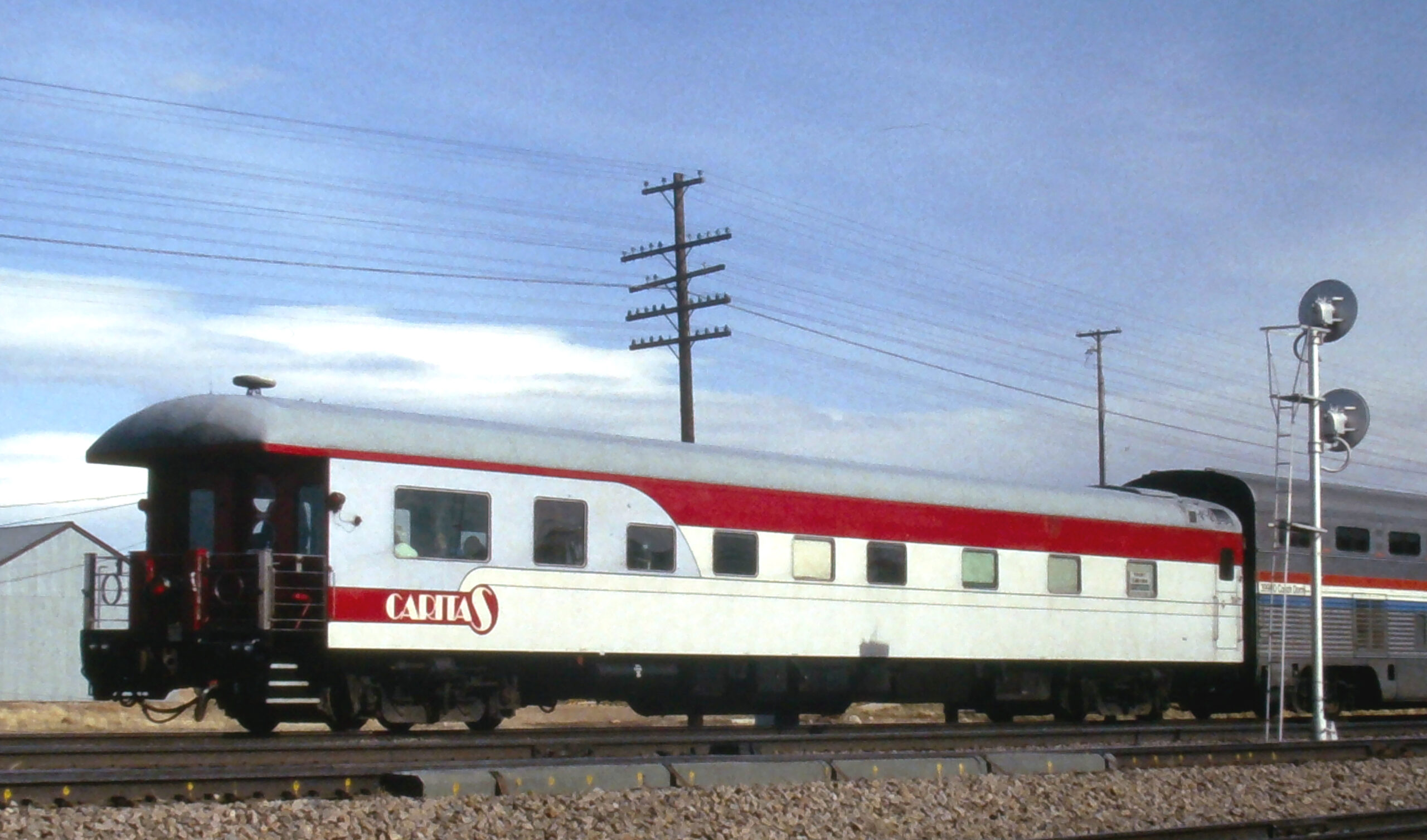 The private charter passenger car Caritas, a sleeper lounge dining observation car, was built in 1948 for service on the St. Louis-San Francisco streamliner The Texas Special. In 1965 it was sold to Canadian National for their streamliner train The Super-Continental. It was rebuilt as private car Caritas by November 1984. On April 23, 1996, the Caritas ran on the back of the regularly scheduled Amtrak Pioneer, from Portland, Oregon, to Denver, Colorado, where it connected with the eastbound California Zephyr to Chicago, Illinois. Here, the Pioneer and Caritas zip through Laramie, Wyoming, on Union Pacific’s Overland Route (Laramie Subdivision), eastbound to Cheyenne (Borie), before turning south on UP’s Denver Pacific line (Greeley Subdivision) to Denver. The last trip of the since discontinued Pioneer took place on May 10, 1997.
The private charter passenger car Caritas, a sleeper lounge dining observation car, was built in 1948 for service on the St. Louis-San Francisco streamliner The Texas Special. In 1965 it was sold to Canadian National for their streamliner train The Super-Continental. It was rebuilt as private car Caritas by November 1984. On April 23, 1996, the Caritas ran on the back of the regularly scheduled Amtrak Pioneer, from Portland, Oregon, to Denver, Colorado, where it connected with the eastbound California Zephyr to Chicago, Illinois. Here, the Pioneer and Caritas zip through Laramie, Wyoming, on Union Pacific’s Overland Route (Laramie Subdivision), eastbound to Cheyenne (Borie), before turning south on UP’s Denver Pacific line (Greeley Subdivision) to Denver. The last trip of the since discontinued Pioneer took place on May 10, 1997.  Union Pacific track geometry vehicle EC-4 served the company by unintrusively inspecting the railroad using the latest technology (for 2008 in this case). A variety of measuring systems and sensors collect data to create a profile of the track, including its position, curvature, smoothness, whether the two rails are level, and the alignment of the track. The purpose is to evaluate track wear and to test for defects to help prevent derailments, increase track longevity and maintain a healthy rail infrastructure. Union Pacific EC-4 is one of two Austrian-built track evaluation cars, this one built in 1999. A similar EC-5 was built in November 2005. Both feature military-grade navigation and cover a combined 70,000-80,000 track miles per year, enough to evaluate the railroad’s mainlines about twice a year.
Union Pacific track geometry vehicle EC-4 served the company by unintrusively inspecting the railroad using the latest technology (for 2008 in this case). A variety of measuring systems and sensors collect data to create a profile of the track, including its position, curvature, smoothness, whether the two rails are level, and the alignment of the track. The purpose is to evaluate track wear and to test for defects to help prevent derailments, increase track longevity and maintain a healthy rail infrastructure. Union Pacific EC-4 is one of two Austrian-built track evaluation cars, this one built in 1999. A similar EC-5 was built in November 2005. Both feature military-grade navigation and cover a combined 70,000-80,000 track miles per year, enough to evaluate the railroad’s mainlines about twice a year. 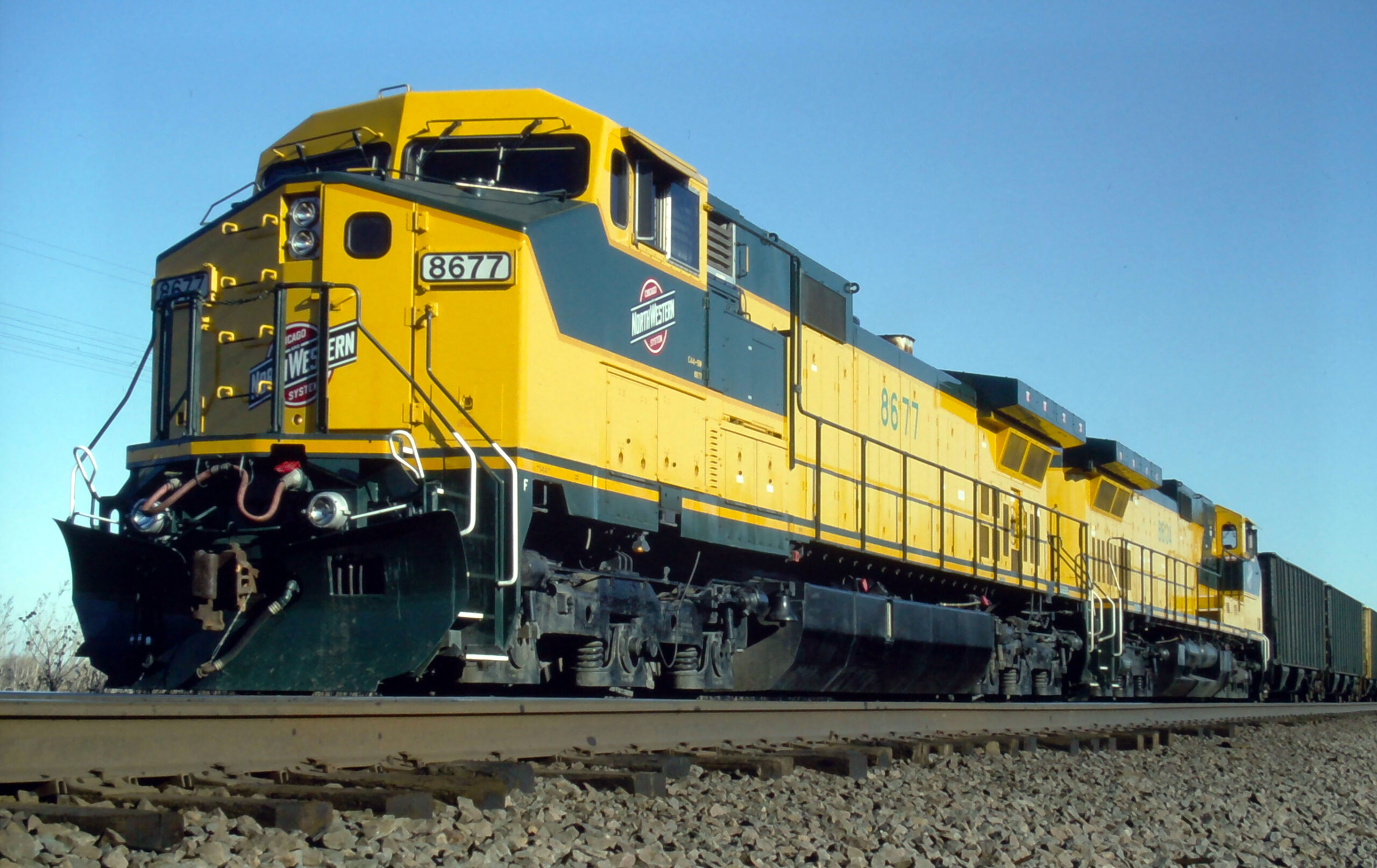 The once proud and historic Chicago & North Western Railroad was absorbed into the massive Union Pacific rail network in April 1995. The finer details of the merger were completed the following June. Out on the railroad right-of-way, C&NW locomotives could be seen leading trains anywhere on Union Pacific’s Overland Route, especially east of North Platte, Nebraska. In December 1995, C&NW C44-9W no. 8677 waited in the siding with a coal train, on home rails, near Marshalltown, Iowa. This General Electric locomotive looked sharp, having been built just a year prior to the merger, in April 1994. It would eventually be renumbered and repainted Union Pacific no. 9781.
The once proud and historic Chicago & North Western Railroad was absorbed into the massive Union Pacific rail network in April 1995. The finer details of the merger were completed the following June. Out on the railroad right-of-way, C&NW locomotives could be seen leading trains anywhere on Union Pacific’s Overland Route, especially east of North Platte, Nebraska. In December 1995, C&NW C44-9W no. 8677 waited in the siding with a coal train, on home rails, near Marshalltown, Iowa. This General Electric locomotive looked sharp, having been built just a year prior to the merger, in April 1994. It would eventually be renumbered and repainted Union Pacific no. 9781. Leased SD60 no. 9078 from EMD (General Motors Electro-Motive Division, later Electro-Motive Diesel) leads an eastbound intermodal train through Boone, Colorado, on the Pueblo Subdivision during the summer of 2008. Burlington Northern Santa Fe leased several locomotives to provide extra motive power during surges in rail traffic. The EMD-built SD60, built in the mid-1980s, was the first microprocessor-controlled diesel locomotive, a substantial predecessor to the SD70M, SD70MAC and SD70ACe.
Chicago commuter railroad Metra F40PH, no. 125, leads a northbound Milwaukee North commuter train of bi-level Gallery Cars in 1997. Here in Grayslake, Illinois, the former Chicago, Milwaukee, St. Paul and Pacific (The Milwaukee Road) crossed Wisconsin Central’s former Soo Line at grade. Metra operated its North Central Service over this Wisconsin Central line, later to become part of the massive Canadian National Railway system.
Illinois Central SD40A no. 6007 and former Burlington Northern SD40-2 no. 6111 (ex-BN 6720) lead a freight train south from Chicago through University Park, Illinois. The sun is setting on this December 1995 evening at the last stop on Metra’s former IC electrified suburban commuter service (track in the foreground with overhead wire). This is the final era of the historic Illinois Central Railroad before its absorption into the massive Canadian National rail empire in 1999.
CEFX AC4400CW no. 1020, a CIT Equipment Finance lease unit, operated as one of two helper units on the rear of a southbound Burlington Northern Santa Fe coal train. At sunrise during the early 2000s, the coal train had just passed under the Cimarron Street bridge in Colorado Springs. Soon it would clear Las Animas and South Sierra Madre Street grade crossings.
Battle-worn Southern Pacific SD45T-2 no. 6850 is representative of the uniqueness and style of SP’s motive power fleet. Only the SP and Denver & Rio Grande Western owned Tunnel Motors, and only SP owned the SD45 model version. Here, on a clear day out West, no. 6850 charges across the desert to deliver a mixed freight of goods to market.
The Ringling Bros. and Barnum & Bailey Blue Unit circus train traversed the nation, providing a home and transportation for act performers and support personnel, who were the life blood of the circus. In 2008, the freight half crossed Las Animas Street, just south of downtown Colorado Springs, before connecting up with the passenger half, parked near Uintah Street. Next stop, Las Vegas, Nevada, north up the Colorado Joint Line and eventually west on the Union Pacific Overland Route.
The Midland hiking trail paralleled U.S. Hwy 24, the Midland Freeway, west out of Manitou Springs, Colorado. The hiking trail is one of many remnants of the once proud Midland Terminal Railway, a successor to the original Colorado Midland Railway. The Colorado Midland was one of the many great mountain railroads which met the challenge of overcoming the Rocky Mountains, including the crossing of the Continental Divide at Hagerman Tunnel.
Amtrak’s westbound train number 3, the Southwest Chief, storms past a 1920s-era semaphore signal, installed by the once proud Santa Fe Railway. Such historic train control equipment remained on the former Santa Fe Raton and Glorieta Subdivisions, traversed by Amtrak since May 1, 1971. The last car on this train number 3 is a Pacific Surfliner coach heading for California.
General Motors Electro-Motive Division SD60 no. 9040 is the trailing unit of a northbound Burlington Northern Santa Fe freight train, which was pulling into the siding, just south of downtown Colorado Springs, Colorado. No. 9040 is a “power by the hour” lease unit in BNSF’s motive power pool. BNSF only pays for the time that the unit is in use, not when it’s sitting on railroad property idle.
Early 20th century semaphore signals were still in use protecting train movements on the Raton Subdivision of the old Santa Fe Railway. The semaphore signals date back to the 1920s, during the steam era of Santa Fe’s famous Chief and other trains. Amtrak’s eastbound train no. 4, the Southwest Chief, blasted past a pair of semaphores guarding the passing siding in Wagon Mound, NM, in April 2021.
On September 10th, 2021, the eastbound Rocky Mountaineer was holding the mainline as it passed the siding signals in Winter Park, Colorado. Leading the charge was Union Pacific SD70M no. 4413, built in July 2001 by General Motors Electro-Motive Division (EMD). The luxury passenger train tour was entitled, “Rockies to the Red Rocks,” and operated between Denver, Colorado, and Moab, Utah. This was its inaugural season on the former Denver & Rio Grande Western Moffat Tunnel Route.
In Denver, Colorado, the local bus transit agency inaugurated its first electrified light rail line on October 7, 1994. Regional Transportation District (RTD) light rail vehicles served a circulator downtown streetcar loop. Then they trundled south along Santa Fe Drive to Mineral Avenue in the inner ring suburb of Littleton. In March 1995, shiny new electric streetcars, such as the light rail vehicle pictured, graced this brand new rail mass transit system. LRV no. 104 just completed the downtown circulator with the Denver skyline in the background.
Rocky Mountaineer SD70M 5107 and 5105 lead its namesake train over the Colorado River, westbound, near Burns, Colorado, in August 2021. These former Union Pacific engines look a little junky compared to the luxury passenger train that they are hauling. The Rocky Mountaineer was made famous in Canada. This is its first year operating on Union Pacific’s Central Corridor, including the Moffat Tunnel Route.
The trailing unit of this southbound Burlington Northern freight train is General American Transportation (GATX) SD40-2 no. 7374. The engines just cleared the Baptist Road grade crossing, just south of Monument, Colorado, in 1995. Leasing companies such as GATX provided extra locomotives to railroads during moments of surging rail traffic. The agreement was called “Power by the Hour,” to which a railroad only paid for a leased locomotive on its property while it was in service.
Union Pacific SD90/43MAC no. 8220 leads a westbound grain train near Roscoe, Nebraska, in 2008. General Motors Electro-Motive Division promised to develop a 6000 horsepower “H” engine during the 1990s. The SD90MAC was to be that engine. Alas, few genuine H-engines were made. Most SD90MAC units were equipped with 4300 horsepower motors. Eventually, the Union Pacific would begin storing their 90MACs and putting many of them up for sale. Norfolk Southern purchased several for its SD70ACU rebuild program.
Chicago South Shore & South Bend freight diesel, GP38-2 no. 2003, leaves the rail yard in Michigan City, Indiana, to begin a day of assembling and hauling local freight trains. SouthShore Freight was a separate entity from the commuter interurban railroad operated by the Northern Indiana Commuter Transportation District. This was primarily a bridge route freight railroad, connecting to Eastern and Western Class One railroads at either end of its rail system.
Burlington Northern Santa Fe SD40-2 no. 6994 leads a manifest freight southbound through Palmer Lake, Colorado, on March 29, 2008. Having reached the top of the Palmer Divide, the train is about to descend the mountainous Joint Line as it heads to Pueblo. Railroads like BNSF continue to use their EMD SD40-2 units because they are such great workhorses.
Burlington Northern Santa Fe C44-9W no. 5228 leads a southbound freight past the grain elevators in Broomfield, Colorado, in May 2021. The Front Range Subdivision is the former Colorado & Southern line through Boulder and Loveland that runs closest to the mountains on the Front Range of the Rocky Mountains.
The 1960s-era EMD GP30 continues to operate in freight service, and occasionally mainline service, sixty years later. Of course, the locomotives have been rebuilt, in some cases several times, so that they may continue to haul freight. Burlington Northern Santa Fe keeps their GP30 fleet upgraded and operating in the 21st Century, reclassified as GP39M and GP39-3, among other rebuilds. Here former Santa Fe GP30 no. 1229, built in June 1962, still sports its Santa Fe yellow-bonnet paint scheme, renumbered as BNSF 2429. It was running in third position as it aided a southbound BNSF freight train through Bragdon, Colorado, during the early 2000s.
Three brand new Southern Pacific AC4400CW diesels, built by General Electric, lead a coal train westbound near Cotopaxi, Colorado, along the Arkansas River, during the summer of 1996. The train has already been through the Royal Gorge and is heading for the Continental Divide tunnel at the top of Tennessee Pass. This is the famous Tennessee Pass Route of the old Denver & Rio Grande Western Railroad, since closed by SP merger partner Union Pacific.
The classic Rio Grande Ski Train, from Denver to Winter Park, Colorado, traversed the mountainous Moffat Tunnel Route, through the Continental Divide, during the winter of 2008. On the point, crossing Coal Creek Viaduct in the snow, is former Amtrak F40PH no. 242, built by EMD in October 1977. Burlington Northern Santa Fe, Union Pacific, and Amtrak’s California Zephyr also traversed this former Denver & Rio Grande Western line.
Union Pacific 4-8-8-4 (Big Boy-class) no. 4014, was scheduled to operate westbound out of Sharon Springs, Kansas, to Limon, Colorado, on November 23, 2019. Sharon Springs was located on the lightly used Kansas Pacific line, between Denver, Colorado, and Kansas City, Missouri. Number 4014 was built in November 1941, retired about twenty years later in December 1961, then rebuilt for special service on the UP by May 2019.
The Grandluxe Express, formerly the American European Express and the American Orient Express, was finally discontinued during the recession of 2007. Here, one of the final runs of the Grandluxe Express charges westbound through South Canyon, having just traversed the scenic Glenwood Canyon, along the Colorado River.
Amtrak’s “California Zephyr,” train no. 5, hustled westbound toward the County Road 57 grade crossing, just west of Granby, Colorado, in 2015. On the rear were three private passenger cars, which belonged to the San Luis & Rio Grande, a tourist railroad in Alamosa, Colorado. In order of succession, they were Pullman sleeper “Baton Rouge,” Domeliner “Sky View,” and Pullman sleeper “Colorado Pine.”
Much can change in railroading over the course of 20 years. In 1987, a quartet of Santa Fe SD40-2 units would have been in charge of a westbound double stack train, leaving Amarillo, Texas, on the Transcon (see inset). In May 2007, Burlington Northern Santa Fe C44-9W 5261 and two sisters power out of Amarillo westbound, providing the same service.
An SPSF (Southern Pacific Santa Fe) SD45-2, shot in 1986, is overtaken by a BNSF (Burlington Northern Santa Fe) SD70MAC, coming around on the mainline in 2006. The SPSF merger was still-born and never materialized, in contrast to the much more successful BNSF merger of the mid 1990s. These are video images taken from the exact same spot, but 20 years apart chronologically. The location is the South Sierra Madre Street crossing in Colorado Springs.
Denver & Rio Grande Western GP30 no. 3006 waits to begin its day’s assignments, early in the morning in 1994. This was the local switch engine for the Rio Grande and Southern Pacific railroads for many years in Colorado Springs. Its primary task was to switch freight cars in the local downtown rail yard, and deliver many of those cars to local rail customers in the surrounding metropolitan area. No. 3006 has since been placed on the Colorado Historic Register for the purpose of preservation.
Canadian National number 9432 is a GP40-2LW, built in 1974, and unique to this railroad. It is an early wide cab design which inspired wide or safety cab designs in the United States, beginning in the late 1980s. Canadian Pacific and Canadian National rail lines paralleled each other on opposite banks of the Fraser River in British Columbia, Canada
In 1990, pre-merger railroads Burlington Northern, Soo Line, and Chicago & North Western moved heavy freight trains throughout the Midwestern United States. The Soo Line ran the “Victorian Express” passenger train from St. Paul to Winona, Minnesota, and return, in celebration of Victorian Days in Winona.
Denver & Rio Grande Western 5366 is a “tunnel motor” SD40T-2 diesel locomotive. It is in charge of a southbound coal train going through Kelker, just south of Colorado Springs, Colorado, in 1983. Tunnel motors were unique to the Rio Grande and Southern Pacific railroads because of their mountainous rail lines3
